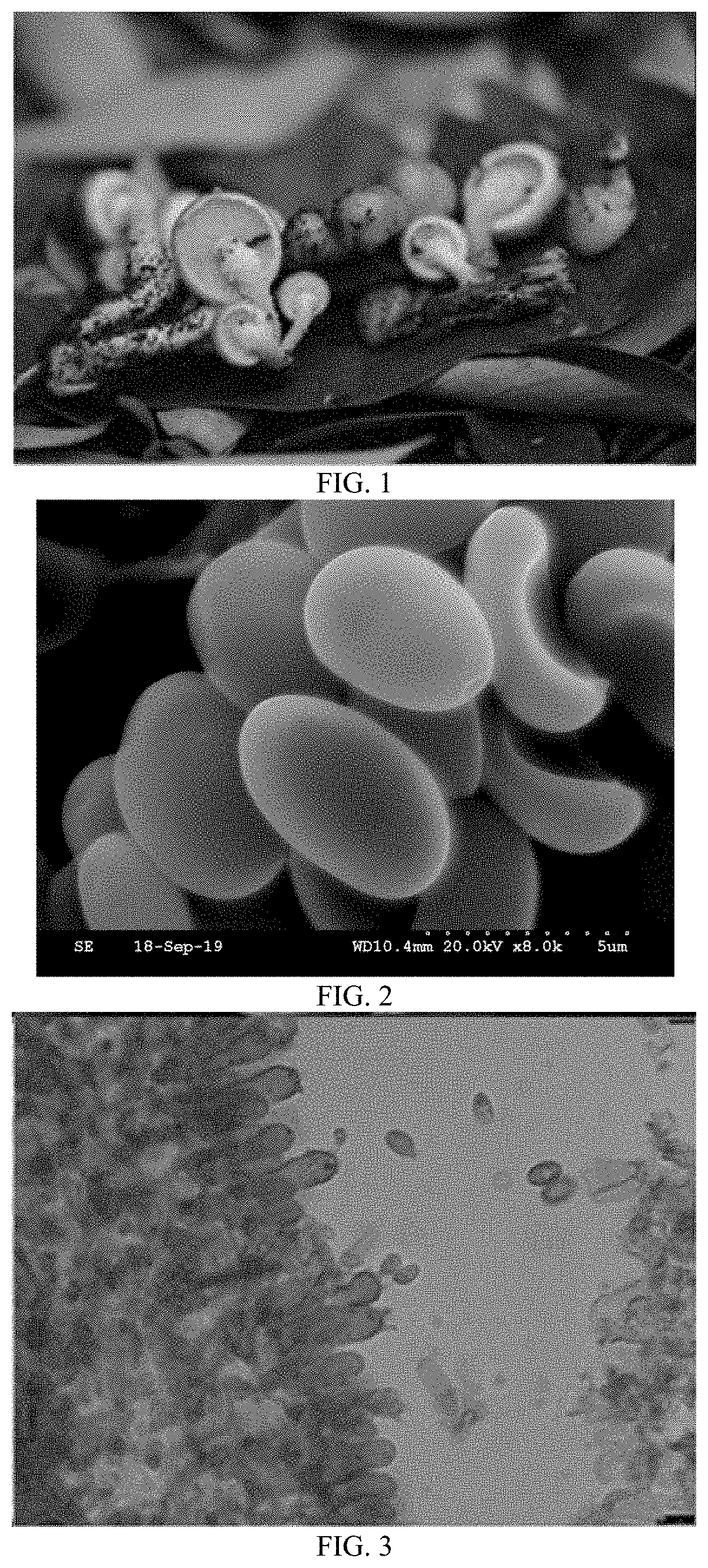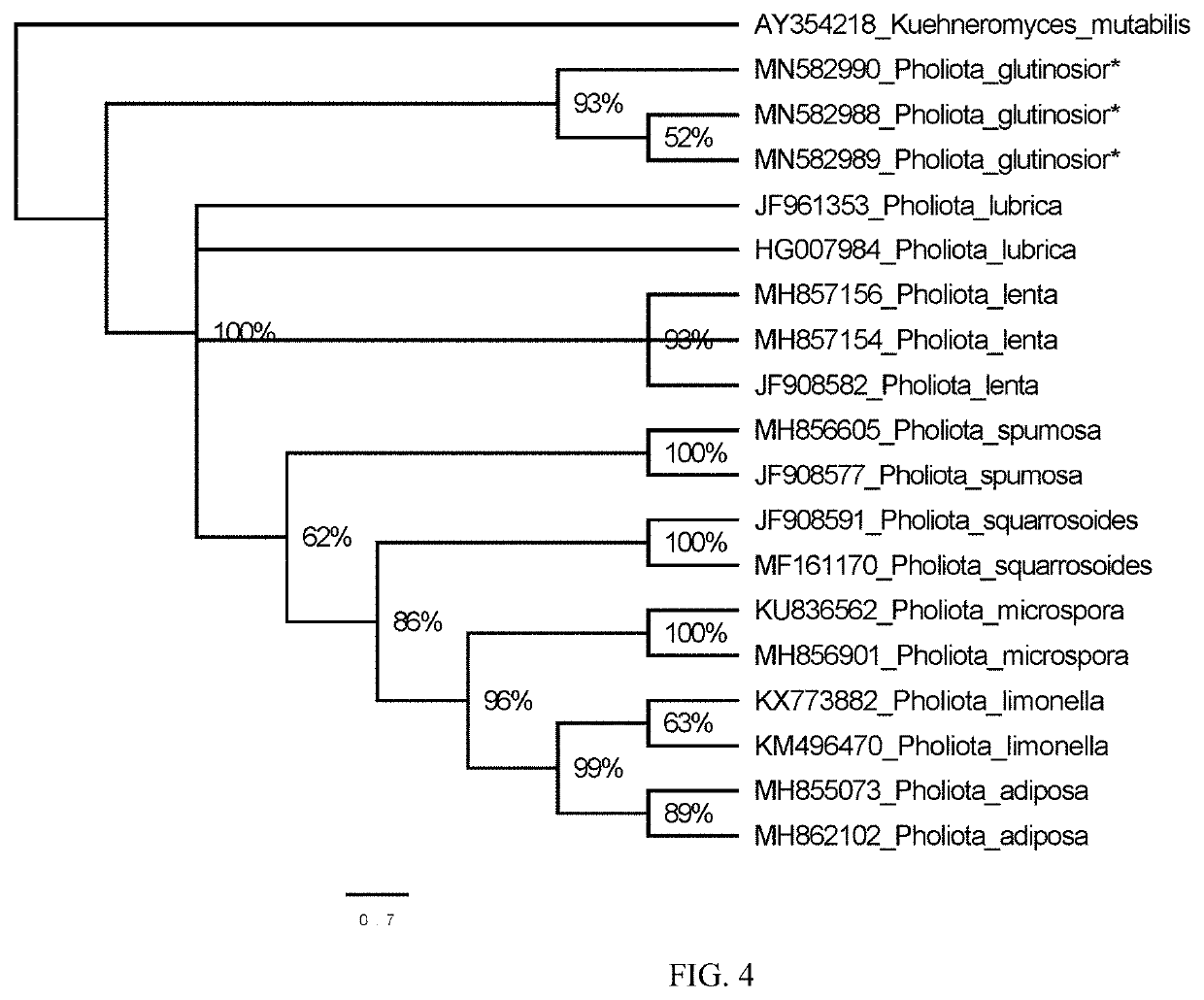Species of Genus Pholiota and Artificial Cultivation Method and Use Thereof
a cultivation method and a new species technology, applied in the field of rare edible fungus new species and artificial cultivation methods, can solve the problems of large number of wild edible medicinal fungi that have not been studied, no more evidence to support a certain point of view, and too small kumm/i>. , to achieve the effect of high cultivation yield, strong and significant inhibition rate, and high content of histidin
- Summary
- Abstract
- Description
- Claims
- Application Information
AI Technical Summary
Benefits of technology
Problems solved by technology
Method used
Image
Examples
example 1
ation of New Strain
[0073]On Mar. 22, 2014, Hu Huiping and Liu Yuanchao collected and investigated large-scale fungal resources in the Chebaling National Nature Reserve, Guangdong Province. A specimen of genus Pholiota was collected on the dead wood, as shown in FIG. 1. FIG. 2 and FIG. 3 are micrographs of the structure, and the original strain was obtained by tissue isolation, named HMGIM-W140054, deposited on Jun. 3, 2019, at China Center for Type Culture Collection (CCTCC, Wuhan, China), with the accession number CCTCC NO: M 2019414.
[0074]Since it did not find the species of genus Pholiota that was consistent with its description in the macroscopic and microscopic morphology, in order to further confirm its classification, DNA extraction was performed, and the genes of the multiple fragments were sequenced, including the fungal ribosomal intergenic region ITS, ribosomal large subunit LSU, a second large subunit RPB2 encoding RNA polymerase II, and the like, which are used for fung...
example 2
Artificial Cultivation
[0099]1. Medium (by Weight Percent):
[0100](1) Tissue Separation Medium (Integrated Potato Dextrose Agar):
[0101]Potato 20%, glucose 2%, agar 2%, potassium dihydrogen phosphate 0.3%, magnesium sulfate 0.15%, and vitamin B1 trace, the rest is water.
[0102](2) Purified First-Class Strain Medium (Bengal Red Medium):
[0103]Peptone 0.5%, glucose 1%, potassium dihydrogen phosphate 0.1%, magnesium sulfate (MgSO4.7H2O) 0.05%, agar 2%, 1 / 3000 Bengal red solution 10%, and chloramphenicol 0.01%, and the rest was water.
[0104](3) Second-Class Strain Culture Medium (Plus Rich Potato Dextrose Agar):
[0105]Potato 20%, glucose 2%, peptone 1%, agar 2%, potassium dihydrogen phosphate 0.3%, magnesium sulfate 0.15%, and vitamin B1 trace, the rest is water.
[0106](4) Third-Class Strain Culture Medium:
[0107]98-99% sorghum, and 1-2% calcium carbonate.
[0108](5) Cultivation Materials:
[0109]31% cottonseed hulls, 58% wood chips, 10% bran, and 1% CaCO3; moisture content 60%-65%.
[0110]2. Method:
[...
example 3
Determination of Antibacterial Activity of Fermentation Broth
[0135]1. Method
[0136](1) Preparation:
[0137]Bacterial medium: nutrient agar / broth medium;
[0138]Nutrition agar / broth medium: beef paste 3 g, peptone 10 g, sodium chloride 5 g, agar 15 g, add water to 1000 ml, and adjust the pH to 7.4 (nutrient broth without agar).
[0139]Preparation of ethyl acetate extract: using rice medium (formulated rice and water), the strain of the present invention was incubated and cultured for 45 days, ethyl acetate was added, ultrasonic extraction was performed twice, 40 minutes for each time, and the extract was combined. The solvent was recovered in a rotary evaporator, and steamed to about 1-2 mL of the extract, and transferred to a collection bottle, the ethyl acetate extract is obtained and placed in a vacuum desiccator. After the solvent was completely evaporated, it was transferred to a refrigerator at 4° C. for use, and was filtrated and sterilizd with the bacteria syringe and filter for use...
PUM
| Property | Measurement | Unit |
|---|---|---|
| weight percent | aaaaa | aaaaa |
| weight percent | aaaaa | aaaaa |
| weight percent | aaaaa | aaaaa |
Abstract
Description
Claims
Application Information
 Login to View More
Login to View More - R&D
- Intellectual Property
- Life Sciences
- Materials
- Tech Scout
- Unparalleled Data Quality
- Higher Quality Content
- 60% Fewer Hallucinations
Browse by: Latest US Patents, China's latest patents, Technical Efficacy Thesaurus, Application Domain, Technology Topic, Popular Technical Reports.
© 2025 PatSnap. All rights reserved.Legal|Privacy policy|Modern Slavery Act Transparency Statement|Sitemap|About US| Contact US: help@patsnap.com



